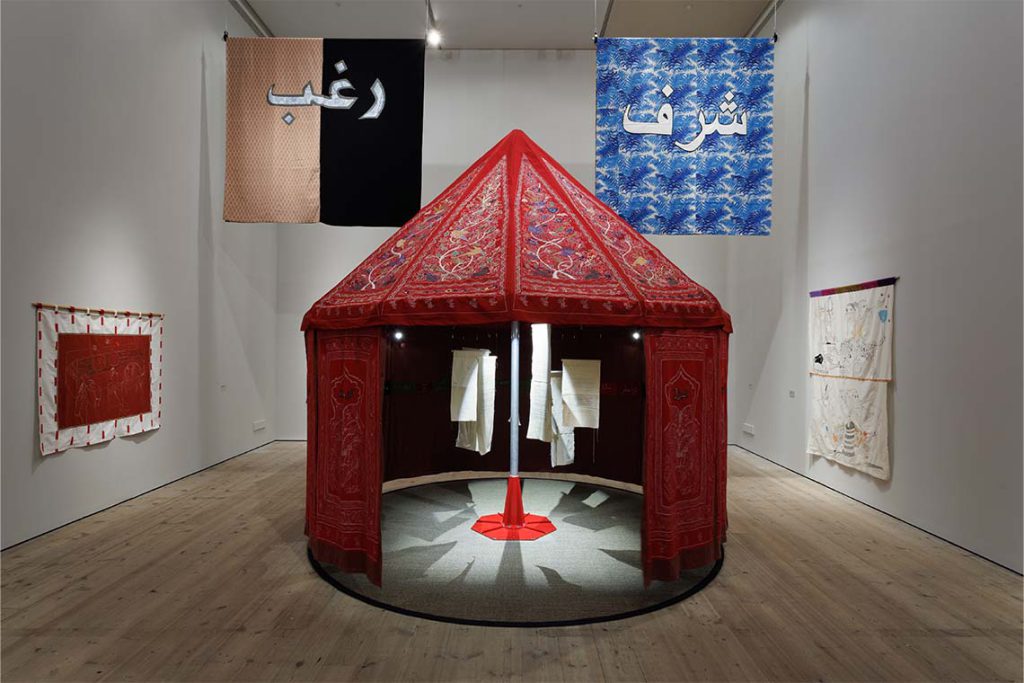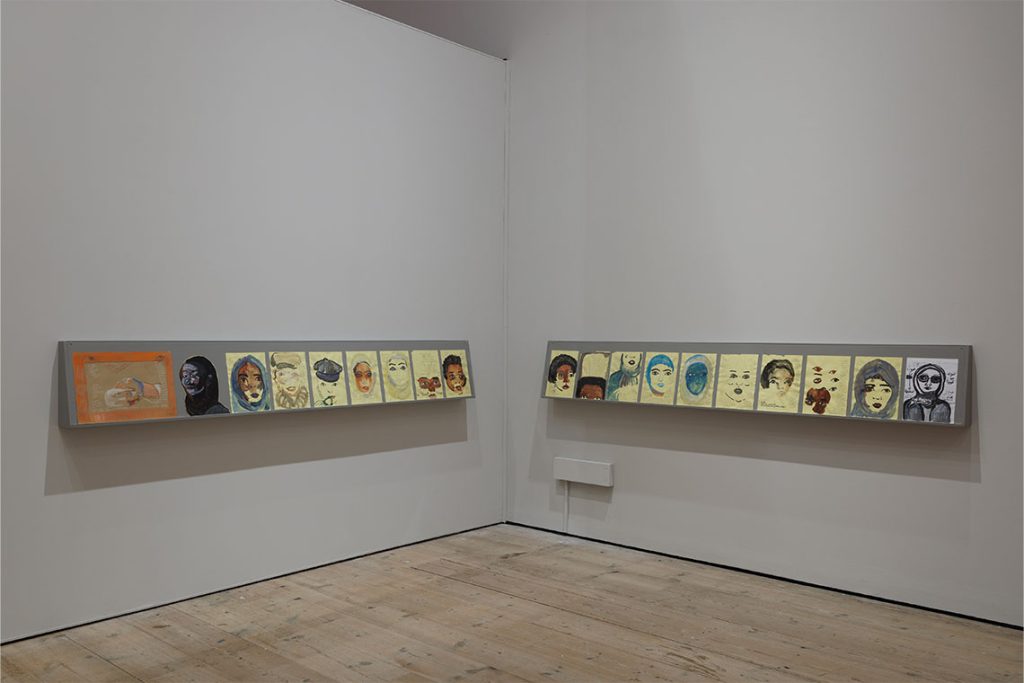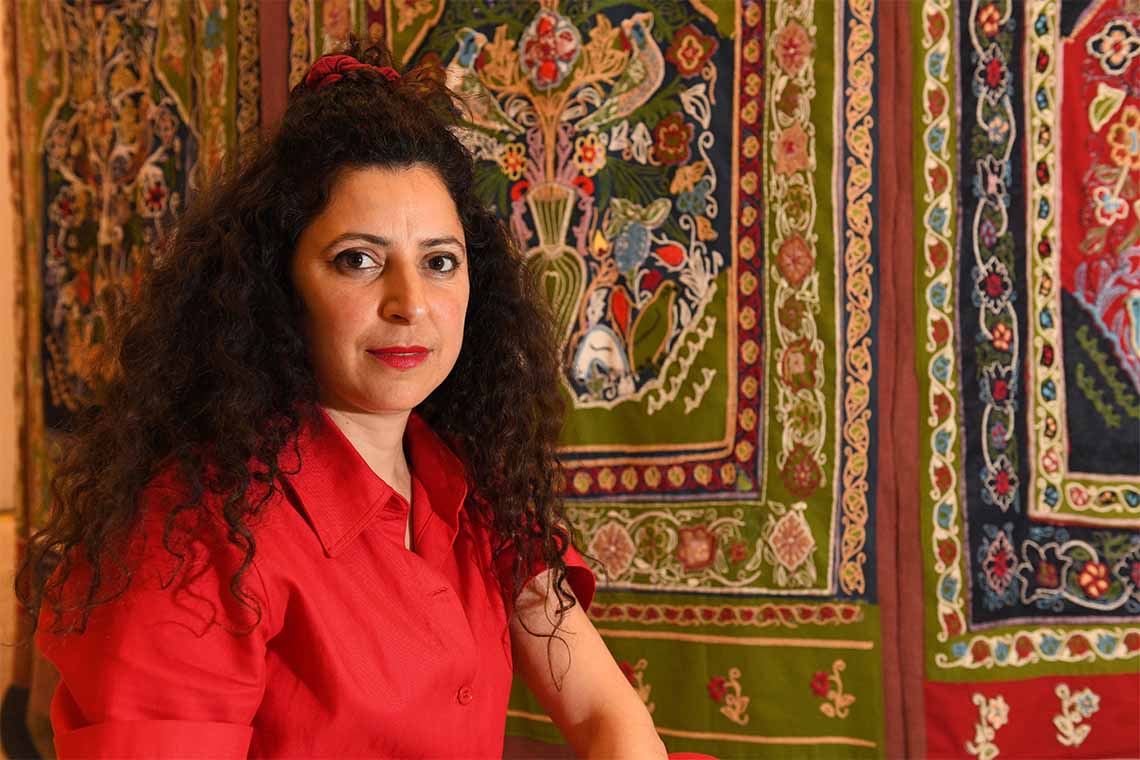Driven by a conviction that some of the most compelling stories are never heard, the artist works to lift the lid on hidden histories.
An opulent ceremonial round tent made in the 19th century and currently owned by the Cleveland Museum of Art was produced for the Qajar emperor of Iran, Muhammad Shah, as an expression of his wealth and royal power. Some two centuries later, the magnificent antique captured the imagination of Lebanese artist Mounira Al Solh, who has been hand-embroidering her own tents since 2017. Could the very same protective and communal – yet equally majestic and theatrical – structure be a fitting venue for women to gather and share their untold stories?
The need for such a space had felt urgent to Al Solh since she had, in recent years, come to feel “marked by so many women around me in Lebanon who had gone through terrible issues because of patriarchy.” These commonplace, painful experiences, such as the loss of access to children after divorce, had been persistently squashed and ignored.
Al Solh made her own tent, A day is as long as a year (2022), which was exhibited last year at the Baltic Centre for Contemporary Art in Gateshead, England. The immense work was a team effort between the artist and about 30 other creatives, including craftswomen from her community in Beirut and asylum seekers from Turkey and Iran whom she met while living in The Netherlands. Quoting many of the same exquisite motifs as the original tent, Al Solh also handwove women’s stories into the fabric between the motifs. One of these accounts comes from someone who was close to the 2020 explosion in Beirut. “The tent was also made to acknowledge mourning and sadness, because we went through that and miraculously we survived,” explains Al Solh. “But instead of accepting that, I only had a guilty feeling that stayed with me for a long time. There was also coronavirus at the same time, so this was a way of acknowledging that we need time to heal from disasters.”
The therapeutic potential of working with textiles has long been intuitive to Al Solh. Born in Lebanon in 1978, some of her earliest memories include helping her Syrian grandmother produce dresses for special occasions. “It had to be perfect,” she recalls. “But, of course, if I remember now, the dresses never really came out perfect, which I really like, actually.” Al Solh’s mother also allowed her to poke holes into her pyjamas and stitch them back up in the evenings. This calming activity would gently lull her to sleep, a small but helpful antidote to some of the traumatising disruptions of civil war, including frequent power cuts and missile strikes. “We kind of kept some normality by doing this exercise,” she muses. Equally, Al Solh enjoyed helping her parents out with odd jobs, including designing letterheads for her father on his typewriter and making posters to advertise her mother’s daycare centre. “I was already dealing with colour, composition and lines,” she recalls.

After the war had officially ended in 1990, Beirut began to open up and outside cultural influences arrived with the return of formerly exiled citizens. Al Solh spent her teenage years exploring the city and playing in a band with friends. In the evening, she found time to paint and rifle through her father’s books and LPs, but for several years after leaving school she resisted further education. “I told my Mom, listen, I’m an artist so I don’t need to study,” she says. Eventually she took up art classes and her mother privately convinced her teacher to push her towards enrolling on the BFA painting course at the Lebanese University.
An even bigger breakthrough, however, would be Al Solh’s participation in an art competition held at The Egg in Beirut in the early 2000s. When she won, she decided to spend the prize money travelling internationally for the first time. Although a new postwar generation of artists was establishing itself and starting to organise shows in the Lebanese capital, “there was no museum, just a very small art circle. I was around 24, and I felt that I was doing art. But I had never seen a museum in my life.”
While visiting relatives in The Netherlands, she fortuitously ran into a Lebanese-Armenian student whom she learned was enrolled at the Gerrit Rietveld Academie, a fine arts and design university in Amsterdam. Intrigued, she took the address and applied, clinching admission with her haunting photographs of war-torn Beirut. Through tender portrayals of locals squatting in abandoned buildings with no infrastructure, the project was a response to the assassination of former prime minister Rafic Hariri, killed in 2005 by a truck bomb that closed one possible avenue for Lebanon’s recovery from war. “We understood that our country was not going to work, but we still needed to keep hope and this brought us back to zero,” Al Solh says, of Hariri’s failed aspiration to rebuild the city. “It showed us that projects for peace would not go on.”

With the sense that trouble was brewing back home, Al Solh hoped to extend her visa and applied for the highly prestigious Rijksakademie residency. It was an opportunity that came with grants, a studio and advisors, as well as the chance to meet other artists. “For the first time I learned to say that I was an artist, because until then I felt very intimidated and insecure about that,” she recalls. “Coming from Lebanon, where being an artist wasn’t really encouraged, The Netherlands was really a blessing because it gave me this affirmation.” Her work, however, took her often to Beirut, where she would eventually settle with her partner and daughter, remaining until 2017 when Lebanon’s economic collapse pushed them to move back to The Netherlands.
On a return trip during Al Solh’s residency, she began making short film studies of her father and his friends going to swim at a local beach. “It’s as if they left Beirut but they never leave,” she says of what drew her to their story. “Just by going to the sea they are already elsewhere. They are not citizens anymore, they make a clique and their social backgrounds don’t matter. The sea binds them together and they are just joking and chilling out.” With her camera, she would follow them as they struggled to navigate sewage and rubbish and find a clean place to swim. “It’s also a little ecological and sociological story about these men who say so much about Beirut.”
Al Solh’s first major project focused on the lives of women was the ongoing I strongly believe in our right to be frivolous. Since 2012, she has used yellow legal pad paper to draw portraits and record the experiences of refugees. Initially, she spoke to Syrians who flooded into Lebanon after once hopeful events like the Syrian revolution and the Arab Spring failed to come to fruition. “I had an urge to welcome them in my own way, because in my childhood I had escaped to Syria from Lebanon,” she says, noting that the arrivals were mostly met with unease from Lebanese people who had memories of conflict between the two countries. “Of course, Beirut is a traumatised place.”
Since moving to The Netherlands, Al Solh has spontaneously expanded the project to include migrants from Iran, Afghanistan and Ethiopia. In each case, her subjects’ first-hand experiences become a path to address the wider political issues that have always made her work so resonant and compelling. “Sitting with people, I’ve learnt a lot of microhistory,” she observes.
This profile first appeared in Canvas 106: Making their Mark



